Aptitude
Question 1 |
(i) Everybody in the class is prepared for the exam.
(ii) Babu invited Danish to his home because he enjoys playing chess.
Which of the following is the CORRECT observation about the above two sentences?
A | (i) is grammatically incorrect and (ii) is ambiguous |
B | (i) is grammatically correct and (ii) is ambiguous |
C | (i) is grammatically correct and (ii) is unambiguous |
D | (i) is grammatically incorrect and (ii) is unambiguous |
ii). Babu invited Danish to his home because he enjoys playing chess.
This statement is ambiguous as there is no guarantee that Danish knows playing chess.
Question 2 |
| Items | Cost (₹) | Profit % | Marked Price (₹) |
| P | 5,400 | --- | 5,860 |
| Q | --- | 25 | 10,000 |

The discount on item Q, as a percentage of its marked price, is ______.
A | 25 |
B | 5 |
C | 10 |
D | 12.5 |
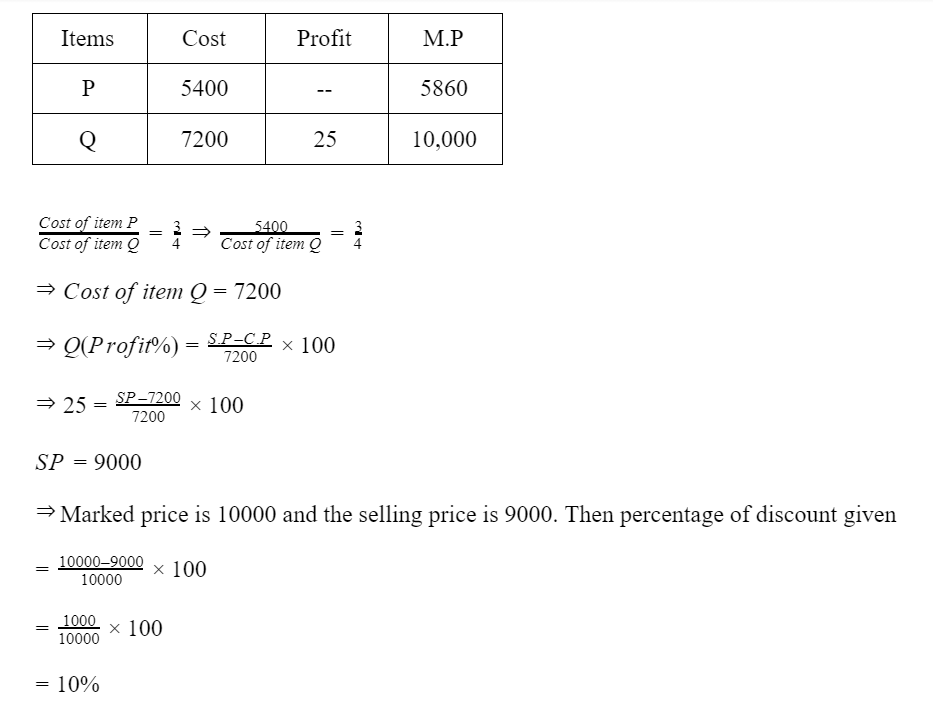
Question 3 |
A | 37 |
B | 73 |
C | 21 |
D | 50 |
Number of boys = 7x
Number of girls = 3x
Total number of students = 10x
So the possible value should multiple by 10.
Answer is 50.
Question 4 |
Which one of the following is NOT a convex polygon?
A |  |
B |  |
C |  |
D |  |

Question 5 |

A circular sheet of paper is folded along the lines in the directions shown. The paper, after being punched in the final folded state as shown and unfolded in the reverse order of folding, will look like _______.
A | 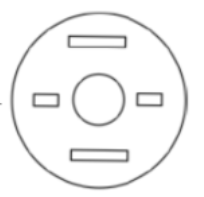 |
B |  |
C |  |
D |  |

Question 6 |
A |  |
B |  |
C |  |
D |  |
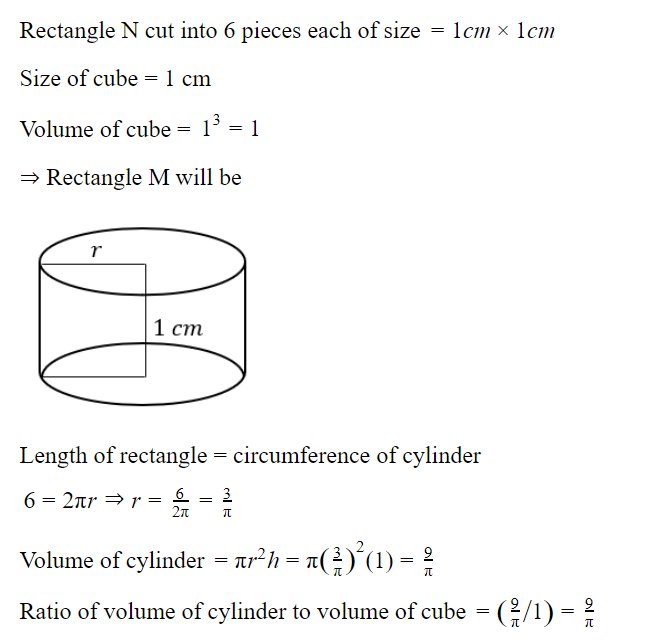
Question 7 |
Which one of the following options maintains a similar logical relation in the above sentence?
A | Hospital, library |
B | Medicine, grammar |
C | Plan, outline |
D | Doctor, book |
Doctor is to surgery as writer is to book.
Question 8 |
A | 0.81225 |
B | 0.4235 |
C | 0.6976 |
D | 0.3024 |
There are 5 bags having identical sets of 10 distinct chocolates. one chocolate is drawn from each bag, probability to find at least 2 chocolate is identical
The total number of such selections possible = 10*10*10*10*10 = 10^5.
We need to select such that at least two of them are identical.
We can count the number of ways with no chocolate being repeated and subtract it from total possible ways to get the required probability.
The number of ways to select all different/distinct = 10*9*8*7*6
Required number of selections= 10^5-10*9*8*7*6 = 69760
Required probability = 69760/10^5 = 0.69760
Question 9 |
Which one of the following statements summarizes the passage?
A | AOM are addressing the problem superficially. |
B | The proposed AOM addresses the core problems that cause obesity. |
C | AOM are addressing the core problems and are likely to succeed. |
D | If obesity reduces, poverty will naturally reduce, since obesity causes poverty. |
Question 10 |
Statement I: All bacteria are microorganisms.
Statement II: All pathogens are microorganisms.
Conclusion I: Some pathogens are bacteria.
Conclusion II: All pathogens are not bacteria.
Based on the above statements and conclusions, which one of the following options is logically CORRECT?
A | Only conclusion I is correct |
B | Only conclusion II is correct |
C | Neither conclusion I nor II is correct |
D | Either conclusion I or II is correct |
Question 11 |
Out of a group of 21 persons, 9 eat vegetables, 10 eat fish and 7 eat eggs : 5 persons eat all three. How many persons eat at least two out the three dishes?
A | Theory Explanation. |
Question 12 |
Two straight lines are drawn perpendicular to each other in X-Y plane. If α and β are the acute angles the straight lines make with the X-axis, then α+β is ______.
A | 60° |
B | 120° |
C | 180° |
D | 90° |

We know a + α + β = 180
α + β = 180 - 90
α + β = 90
Question 13 |
The total revenue of a company during 2014-2018 is shown in the bar graph. If the total expenditure of the company in each year is 500 million rupees, then the aggregate profit or loss (in percentage) on the total expenditure of the company during 2014-2018 is ______.

A | 20% profit |
B | 20% loss |
C | 16.67% loss |
D | 16.67% profit |
2014-2018
Total expenditure = 500 million/year = 500 × 5 = 2500 million
Revenue total (from the graph)
= 400 + 500 + 600 + 700 + 800
= 3000 million
Profit = 3000 - 2500 = 500
⟹ 500/2500 = 20% profit
Question 14 |
The figure below shows an annular ring with outer and inner radii as b and a, respectively. The annular space has been painted in the form of blue colour circles touching the outer and inner periphery of annular space. If maximum n number of circles can be painted, then the unpainted area available in annular space is ______.
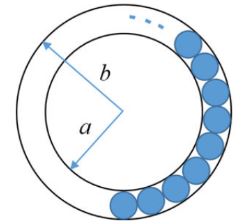
A | π[(b2 - a2) + π/4(b - a)2] |
B | π[(b2 - a2) - π/4(b - a)2] |
C | π[(b2 - a2) - n(b - a)2] |
D | π[(b2 - a2) + n(b - a)2] |

Area of non-painted between 2 circles area of part 1 = πb2 - πa2 = π(b2 - a2)
Radius of painted circles = b-a/2
Area of painted circle = π(b-a/2)2
For n circles = nπ(b-a/2)2
Non-painted area = π[b2 - a2- n/4(b - a)2]
Question 15 |
Goods and Services Tax (GST) is an indirect tax introduced in India in 2017 that is imposed on the supply of goods and services, and it subsumes all indirect taxes except few. It is a destination-based tax imposed on goods and services used, and it is not imposed at the point of origin from where goods come. GST also has a few components specific to state governments, central government and Union Territories (UTs).
Which one of the following statements can be inferred from the given passage?
A | GST includes all indirect taxes.
|
B | GST is imposed at the point of usage of goods and services.
|
C | GST does not have a component specific to UT. |
D | GST is imposed on the production of goods and services.
|
Question 16 |
Select the word that fits the analogy:
Cook : Cook :: Fly : _____
A | Flyer |
B | Flying |
C | Flew |
D | Flighter |
Fly-Flyer
Question 17 |
The drawn of the 21st century witnessed the melting glaciers oscillating between giving too much and too little to billions of people who depend on them for fresh water. The UN climate report estimates that without deep cuts to man-made emissions, at least 30% of the northern hemisphere’s surface permafrost could melt by the end of the century. Given this situation of imminent global exodus of billions of people displaced by rising seas, nation-states need to rethink their carbon footprint for political concerns, if not for environmental ones.
Which one of the following statements can be inferred from the given passage?
A | Nation-states are responsible for providing fresh water to billions of people. |
B | Billions of people are affected by melting glaciers.
|
C | Nation-states do not have environmental concerns. |
D | Billions of people are responsible for man-made emissions. |
Question 18 |
There are multiple routes to reach from node 1 to node 2, as shown in the network.

The cost of travel on an edge between two nodes is given in rupees. Nodes ‘a’, ‘b’, ‘c’, ‘d’, ‘e’, and ‘f’ are toll booths. The toll price at toll booths marked ‘a’ and ‘e’ is Rs.200, and is Rs.100 for the other toll booths. Which is the cheapest route from node 1 to node 2?
A | 1-f-e-2
|
B | 1-f-b-2 |
C | 1-b-2 |
D | 1-a-c-2
|
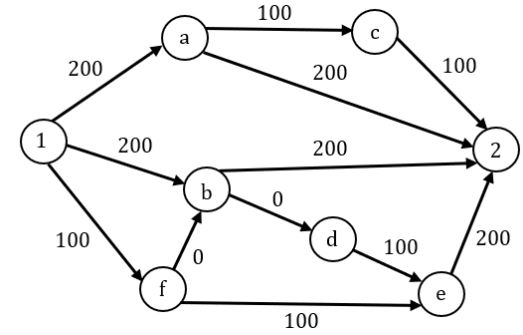
1 - f - e - 2 ─ 100 + 100 + 200 = 400
1 - f - b - 2 ─ 100 + 0 + 200 = 300 ⇾ shortest [Answer]
1 - b - 2 ─ 300 + 200 = 500
1 - a - c ─ 2 - 200 + 100 + 100 = 400
Question 19 |
Raman is confident of speaking English _____ six months as he has been practicing regularly_____the last three weeks.
A | for, in |
B | during, for
|
C | for, since
|
D | within, for
|
Question 20 |
If P = 3, R = 27, T = 243, then Q+S = ______.
A | 80 |
B | 110 |
C | 40 |
D | 90 |
P=31, Q=32, R=33, S=34, T=35
Q+S = 32 + 34 = 9+81 = 90
Question 21 |
His knowledge of the subject was excellent but his classroom performance was ______.
A | good
|
B | praiseworthy |
C | extremely poor |
D | desirable
|
Question 22 |
Ten friends planned to share equally the cost of buying a gift for their teacher. When two of them decided not to contribute, each of the other friends had to pay Rs 150 more. The cost of the gift was Rs. _____.
A | 12000 |
B | 666 |
C | 3000 |
D | 6000 |
Gift cost = 10x
When two people are not going to contribute then remaining friends have to pay Rs 150 more.
Two friends contribution = 150 × 8 = 1200
One friend contribution = 600
Ten friends contribution = 6000
Cost of the Gift = 6000
Method-2: There were ten friends decided to buy a gift.
Out of ten members two members are not able to pay their share.
So, two members amount was paid by remaining eight members.
Then the eight members has to pay 150 more, which is 150*8= 1200( two persons share).
One person share= 1200/2=600.
Ten members share= 600*10= 6000.
Price of the gift= 6000.
Question 23 |
The expenditure on the project _____ as follows; equipment Rs.20 lakhs, salaries Rs.12 lakhs, and contingency Rs.3 lakhs.
A | break down |
B | break |
C | breaks down |
D | breaks |
Question 24 |
The search engine's business model _____ around the fulcrum of trust.
A | bursts |
B | revolves |
C | sinks |
D | plays |
Question 25 |
Two cars start at the same time from the same location and go in the same direction. The speed of the first car is 50 Km/h and the speed of the second car is 60 Km/h. The number of hours it takes for the distance between the two cars to be 20 Km is _____.
A | 2 |
B | 3 |
C | 1 |
D | 6 |
Speed of the second car = 60 km/h
Let no. of hours = x say
⇒ From the question we can write
(60)x - (50)x = 20
10x = 20
∴ x = 2 hrs
Question 26 |
A court is to a judge as _____ is to a teacher.
A | a syllabus |
B | a student |
C | a punishment |
D | a school |
Question 27 |
In a college, there are three student clubs. Sixty students are only in the Drama club, 80 students are only in the Dance club, 30 students are only in the Maths club, 40 students are in both Drama and Dance clubs, 12 students are in both Dance and Maths clubs, 7 students are in both Drama and Maths club, and 2 students are in all the clubs. If 75% of the students in the college are not in any of these clubs, then the total number of students in the college is _____.
A | 900 |
B | 975 |
C | 225 |
D | 1000 |

No. of students present in three student clubs
= 60 + 80 + 30 + 38 + 2 + 10 + 5
= 225 [i.e., 25% of the students in the college]
Total no. of students in the college = 225 × 4 = 900
Question 28 |
The police arrested four criminals - P, Q, R and S. The criminals knew each other. They made the following statements:
-
P says "Q committed the crime."
Q says "S committed the crime."
R says "I did not do it."
S says "What Q said about me is false."
Assume only one of the arrested four committed the crime and only one of the statements made above is true. Who committed the crime?
A | P |
B | Q |
C | R |
D | S |
II, III, IV are false.
II is false: 'S' is not criminal.
IV is also false: 'S' committed crime.
There is conflict among I, IV now as P, S both should be criminals.
⇒ II true: 'S' is criminal.
I, III, IV are false.
IV is false. So, 'S' is not criminal.
III is false. So. 'R' is criminal.
There is conflict among II, III as S, R both should be criminal.
III is true: Criminal ≠ R.
I, II, IV are false.
I is false. So, 'Q' is also not criminal.
II is false. So, 'S' is not criminal.
IV is false. So, 'S' is not criminal.
Q, R, S are not criminals. So, 'P' is criminal.
IV is true: I, II, III are false.
II is false. So, 'S' is not criminal.
IV is true. So, 'S' is criminal.
I is false. So, 'Q' is not criminal.
III is false. So, 'R' is criminal.
There is conflict, as R, S both should be criminals.
Question 29 |
"A recent High Court judgement has sought to dispel the idea of begging as a disease — which leads to its stigmatization and criminalization — and to regard it as a symptom. The underlying disease is the failure of the state to protect citizens who fall through the social security net."
Which of the following statements can be inferred from the given passage?
A | Beggars are created because of the lack of social welfare schemes |
B | Beggars are lazy people who beg because they are unwilling to work |
C | Begging is an offence that has to be dealt with firmly |
D | Begging has to be banned because it adversely affects the welfare of the state |
The court is judged that because of failure of the state to protect citizens through social security schemes beggars are created.
Question 30 |
Three of the five students allocated to a hostel put in special requests to the warden. Given the floor plan of the vacant rooms, select the allocation plan that will accommodate all their requests.
-
Request by X: Due to pollen allergy, I want to avoid a wing next to the garden.
Request by Y: I want to live as far from the washrooms as possible, since I am very sensitive to smell.
Request by Z: I believe in Vaastu and so want to stay in the South-west wing.
The shaded rooms are already occupied. WR is washroom.
A |  |
B |  |
C | 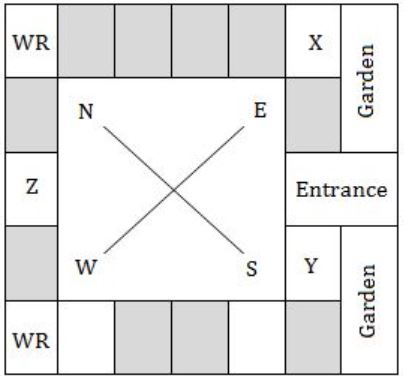 |
D | 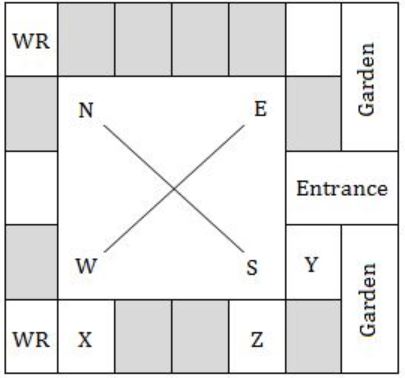 |
Question 31 |
In the given diagram, teachers are represented in the triangle, researchers in the circle and administrators in the rectangle. Out of the total number of the people, the percentage of administrators shall be in the range of _____.

A | 16 to 30 |
B | 0 to 15 |
C | 46 to 60 |
D | 31 to 45 |

From the given diagram:

Total no. of people = 70 + 10 + 20 + 20 + 40 = 160
No. of Administrators = 50
% of Administrators = 50/160 = 31.25
Question 32 |
“From where are they bringing their books? __________ bringing __________ books from __________.”
The words that best fill the blanks in the above sentence are
A | Their, they’re, there |
B | They’re, their, there |
C | There, their, they’re |
D | They’re, there, there |

Question 33 |
"A _______ investigation can sometimes yield new facts, but typically organized ones are more successful."
The word that best fills the blank in the above sentence is
A | meandering |
B | timely |
C | consistent |
D | systematic |
Question 34 |
The area of a square is d. What is the area of the circle which has the diagonal of the square as its diameter?
A | πd |
B | πd2 |
C | (1/2)πd2 |
D | (1/2)πd |
Area of a square A = a2 (where a is side)
In the question,
Area of a square = d
The side of a square = √d
Diagonal of a square = Diameter of circle

From Pythagoras theorem,
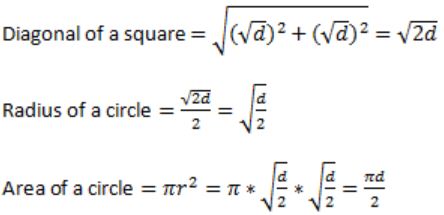
Question 35 |
What is the missing number in the following sequence?
2, 12, 60, 240, 720, 1440, _______, 0A | 2880 |
B | 1440 |
C | 720 |
D | 0 |

2 × 6 = 12
12 × 5 = 60
60 × 4 = 240
240 × 3 = 720
720 × 2 = 1440

1440 × 0 = 0
Question 36 |
What would be the smallest natural number which when divided either by 20 or by 42 or by 76 leaves a remainder of '7' in each case?
A | 3047 |
B | 6047 |
C | 7987 |
D | 63847 |
Take the LCM of 20, 42, 76 i.e., 7980.
⟹ Remainder = 7
⟹ Smallest number divisible by 20 (or) 42 (or) 72 which leaves remainder 7 is = 7980 + 7 = 7987
Method-II:
Option I:
3047 – 7 = 3040
3040 not divisible by 42
Option II:
6040 not divisible by 42
Option III:
7980 divisible by 20, 42, 76
Option IV:
63840 divisible by 20, 42, 76
→ Smallest (7980, 63840) = 7980
→ 7980 + remainder 7 = 7987
Question 37 |
If pqr ≠ 0 and p -x = 1/q, q -y = 1/r, r -z = 1/p, what is the value of the product xyz?
A | -1 |
B | 1/pqr |
C | 1 |
D | pqr |
→ p-x = 1/q ⟹ 1/px = 1/q
⟹ q = px
⟹ log q = log px
⟹ x log p = log q
⟹ x = log q/ log p
→ q-y = 1/r ⟹ 1/qy = 1/r
⟹ qy = r
⟹ y log q = log r
⟹ y = log r/ log q
→ r-z = 1/p ⟹ 1/rz = 1/p
⟹ p = rz
⟹ log rz = log p
⟹ z log r = log p
⟹ z = log p/ log r
XYZ = log q/ log p * log r/ log q * log p/ log r =1
Question 38 |
In the figure below, ∠DEC + ∠BFC is equal to

A | ∠BCD - ∠BAD |
B | ∠BAD + ∠BCF
|
C | ∠BAD + ∠BCD |
D | ∠CBA + ADC |

→ ∠1 = ∠5 + ∠4 ………(i)
According to triangular property:
Angle of exterior = sum of interior angles
→ ∠4 = ∠3 + ∠2 ……….(ii)
By substituting (ii) in (i)
→ ∠1 = ∠5 + ∠3 + ∠2
→ ∠1 = ∠BCD
∠2 = ∠BAD
→ ∠BCD - ∠BAD = ∠1 - ∠2
= ∠5 + ∠3 + ∠2 - ∠2
= ∠ 5 + ∠3
= ∠DEC + ∠BFC
Question 39 |
In a party, 60% of the invited guests are male and 40% are female. If 80% of the invited guests attended the party and if all the invited female guests attended, what would be the ratio of males to females among the attendees in the party?
A | 2:3 |
B | 1:1 |
C | 3:2 |
D | 2:1 |
→ 60% invited guests are males i.e., 60 males
→ 40% invited guests are females i.e., 40 females
→ 80% invited guests are attended i.e., total guests attended to a party = 80
→ All the invited females are attended then remaining people are males = 80 – 40 = 40 males
⇒ 40 males : 40 females
⇒ 1 : 1
Question 40 |
In appreciation of the social improvements completed in a town, a wealthy philanthropist decided to gift Rs 750 to each male senior citizen in the town and Rs 1000 to each female senior citizen. Altogether, there were 300 senior citizens eligible for this gift. However, only 8/9th of the eligible men and 2/3rd of the eligible women claimed the gift. How much money (in Rupees) did the philanthropist give away in total?
A | 1,50,000 |
B | 2,00,000 |
C | 1,75,000 |
D | 1,51,000 |
Female senior citizen’s gift = Rs. 1000
No. of males = a say
No. of females = b say
Altogether no. of persons eligible for gift = 300
i.e., a+b = 300
Total amount be given = (8x/9 × 750) + (2y/3 × 1000)
= (2000x/3) + (2000y/3)
= 2000/3 (x+y)
= 2000/3 (300)
= 2,00,000
Question 41 |
A six sided unbiased die with four green faces and two red faces is rolled seven times. Which of the following combinations is the most likely outcome of the experiment?
A | Three green faces and four red faces. |
B | Four green faces and three red faces. |
C | Five green faces and two red faces. |
D | Six green faces and one red face. |
→ If we roll a die for six time then we get 4 green faces and 2 red faces.
→ And if we roll for seventh time green face can have more probability to become a outcome.
→ Then most likely outcome is five green faces and two red faces.
Question 42 |
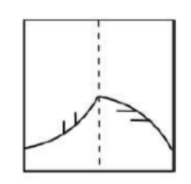
A transparent square sheet shown above is folded along the dotted line. The folded sheet will look like _______.
A | 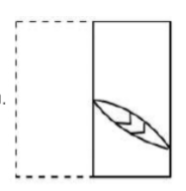 |
B |  |
C | 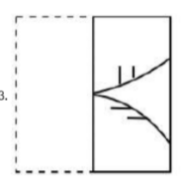 |
D | 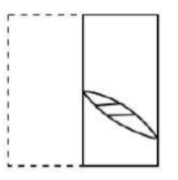 |
Question 43 |
A | as worse as |
B | as well as |
C | as better as |
D | as nicest as |
Question 44 |
A | Vegetables |
B | Sharp |
C | Blunt |
D | Cut |
Question 45 |
A | 66 |
B | 22 |
C | 88 |
D | 110 |
Given Initial ratio : 3:13:6
Total number of students initially = 3x+13x+6x = 22x
From the given question, we can write 3x+18 = 15y -----I
13x+18 = 35y-----II
6x+18 = 21y------III
I - II => -10X = -20Y
X=2Y------IV
Put IV in III => 6(2y) + 18 = 21y
12y + 18 = 21y
9y = 18
y = 2 -----V
Substitute V in I => 3x + 18 = 30
3x = 12
x = 4
Number of initial students = 22x = 22(4) = 88
Question 46 |
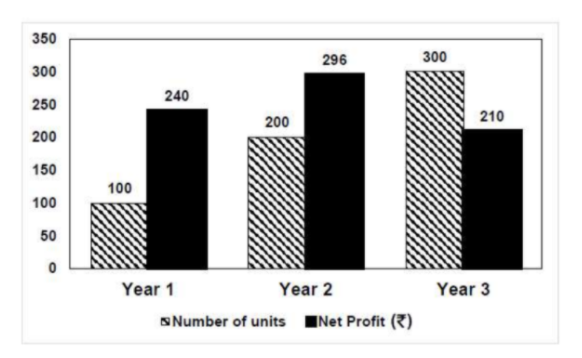
The number of units of a product sold in three different years and the respective net profits are presented in the figure above. The cost/unit in Year 3 was ₹ 1, which was half the cost/unit in Year 2. The cost/unit in Year 3 was one-third of the cost/unit in Year 1. Taxes were paid on the selling price at 10%, 13% and 15% respectively for the three years. Net profit is calculated as the difference between the selling price and the sum of cost and taxes paid in that year.
The ratio of the selling price in Year 2 to the selling price in Year 3 is ______.
A | 1:1 |
B | 3:4 |
C | 1:2 |
D | 4:3 |
According to the given data:
Year Cost/unit Number of units Cost Price
1 ₹ 3 100 300
2 ₹ 2 200 400
3 ₹ 1 300 300
Cost Price = Cost/unit x Number of units
Net Profit = Selling Price - (Cost Price + (Tax% x selling price )
Year 2:
296 = SP - (400 + (13/100) x SP)
=>296 = 0.87SP - 400
=> 0.87SP = 696
=> SP = ₹ 800
Year 3:
210 = SP - (300 + (15/100) x SP)
=> 210 = 0.85SP - 300
=> 0.85SP = 510
=> SP = ₹ 600
The ratio of selling price in Year 2 to the selling price in year 3 = 800:600
= 4:3
Question 47 |

A jigsaw puzzle has 2 pieces. One of the pieces is shown above. Which one of the given options for the missing piece when assembled will form a rectangle? The piece can be moved, rotated or flipped to assemble with the above piece.
A |  |
B | 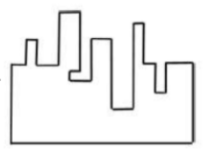 |
C | 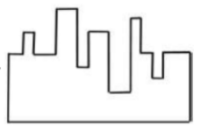 |
D | 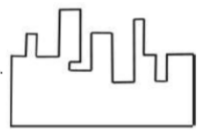 |
Question 48 |
A | 2 |
B | 4 |
C | 8 |
D | 6 |
Expand the given equation:
x2+1/4 - x -x2 -9/4 +3x = x+2
=> -2 + 2x = x + 2
X = 4
Question 49 |
A |  |
B |  |
C |  |
D |  |
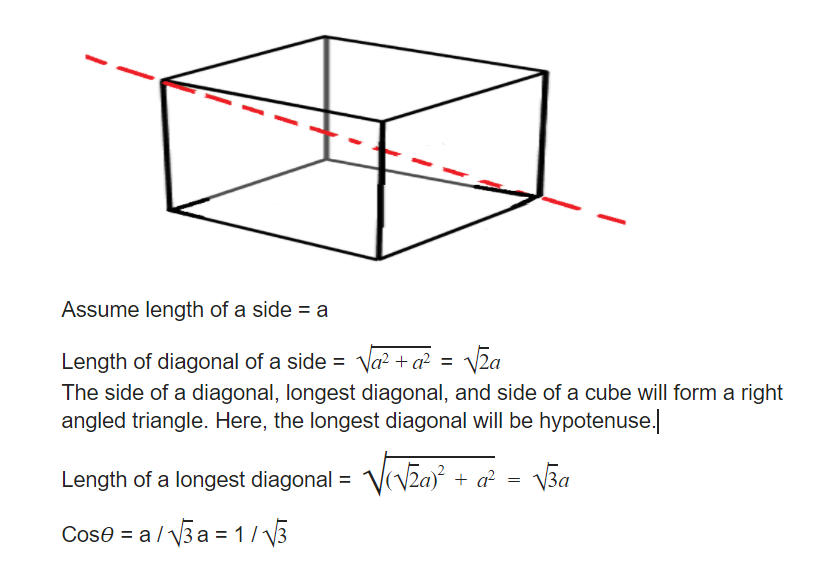
Question 50 |
Observation I: S is taller than R.
Observation II: Q is the shortest of all.
Observation III: U is taller than only one student.
Observation IV: T is taller than S but is not the tallest.
The number of students that are taller than R is the same as the number of students shorter than _______.
A | S |
B | P |
C | T |
D | R |
Number of students taller than R = Number of students shorter than S = 3
